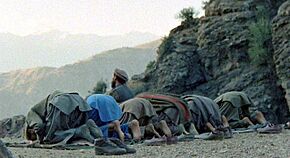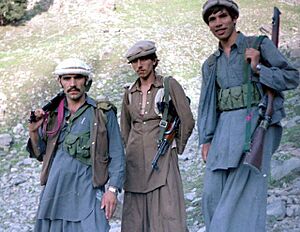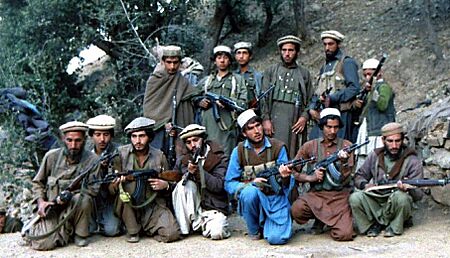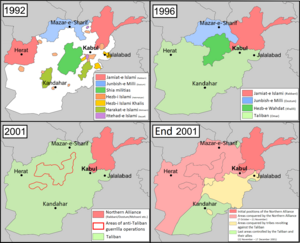Afghan mujahideen facts for kids
Quick facts for kids Mujahideen |
|
|---|---|
| مجاهدين | |

Mujahideen praying (namāz) before the fighting, 1987
|
|
| Active | 1975–1992 (resistance phase) 1992–1996 (loyalist factions) |
| Ideology | Islamism Anti-communism Anti-Sovietism Afghan nationalism |
| Motives | Combat the Soviet invasion of Afghanistan and overthrow the Soviet-backed communist government |
| Leaders | Burhanuddin Rabbani and Ahmad Shah Massoud (Jamiat), Sibghatullah Mojaddedi (JNMA/AIG), Gulbuddin Hekmatyar (HIG), Mohammad Nabi Mohammadi (Harakat), Abdul Ali Mazari (Wahdat) |
| Area of operations |
|
| Succeeded by | Northern Alliance Taliban |
| Allies | |
| Opponents | |
| Battles and wars | 1975 Panjshir Valley uprising
Soviet–Afghan War (1979–1989) First Afghan Civil War (1989–1992) Gulf War (1991) |
| Organizations | "Peshawar Seven" (Sunni branch) Tehran Eight (Shia branch) |
The Afghan mujahideen were groups of fighters in Afghanistan. They were mostly Islamists, meaning their beliefs were based on Islam. These groups fought against the Soviet Union and the communist government of Afghanistan. This conflict happened during the Soviet–Afghan War (1979–1989) and a civil war that followed.
The word mujahid comes from Arabic and means someone who struggles for the sake of Islam. This struggle is often called jihad. The Afghan mujahideen were made up of many different groups. They had different ethnic backgrounds and ideas. However, they all shared a common goal: to fight against communism and support Islamic values. Western news often called them "freedom fighters" or "Mountain Men."
These fighters were organized after the Soviet Union invaded Afghanistan in 1979. They included regular Afghan people and soldiers who left the Afghan army. Their main goal was to fight the communist government that took power in 1978 and the Soviet forces supporting it. Two of the most important groups were Jamiat-e Islami and Hezb-e Islami Gulbuddin.
The Afghan mujahideen were generally split into two main groups. The larger group was the "Peshawar Seven," based in Pakistan. This group was mostly Sunni Muslim. The smaller group was the "Tehran Eight," based in Iran, and was Shia Muslim. The "Peshawar Seven" received a lot of help. This help came from countries like the United States (through Operation Cyclone), the United Kingdom, Pakistan, Saudi Arabia, and China. They also got money from other countries and private donors.
The mujahideen groups were very independent, much like Afghan society itself. They formed a larger alliance under pressure from the US, Saudi Arabia, and Pakistan. This alliance aimed to act as a single voice to the world. Many volunteers from other Muslim countries also came to Afghanistan to help. These international fighters were known as Afghan Arabs. One famous Arab fighter was Osama bin Laden, who later started al-Qaeda.
The mujahideen fought a long and difficult war against the Soviet military. The Soviets suffered heavy losses and left Afghanistan in 1989. After that, the mujahideen continued fighting the communist Afghan government. In 1992, the mujahideen captured the capital city of Kabul. This happened after the Soviet-backed government collapsed. However, the new government formed by the Peshawar Accords quickly broke apart. Different groups started fighting each other. This led to another civil war. During this time, the united Afghan mujahideen fell apart. The Taliban then rose to power, taking control of most of the country by 1996. The Taliban were later removed in 2001 but returned to power in 2021.
Contents
How the Mujahideen Started
Some groups that became part of the mujahideen already existed. For example, Jamiat-e Islami started in 1972 and Hezb-e Islami in 1976. These were like small armies. They took part in early uprisings, such as the 1975 Panjshir Valley uprising.
By late 1978, resistance groups began forming in eastern Afghanistan. In early 1979, the situation quickly turned into an open rebellion. By February 1979, reports said that Afghan rebels were getting training in Pakistan. The conflict grew much worse during the 1979 Herat uprising in March. In Herat, army soldiers and civilians rebelled and briefly took over the city. This event showed that a civil war was coming.
Sibghatullah Mojaddedi, a religious leader, was one of the first to organize an armed group against the government. He created the Afghan National Liberation Front. In May 1979, he asked for support in New York City. Another spiritual leader, Sayyed Ahmad Gailani, also formed a resistance group called the National Islamic Front. Mohammad Nabi Mohammadi, a religious scholar, formed the Revolutionary Islamic Movement.
In August 1979, several groups, including the Afghan National Liberation Front, joined together. They formed a new organization in Peshawar, Pakistan. Their goal was to create an Islamic Republic in Afghanistan. Other rebel groups were also active across the country.
The Pakistani government decided in May 1979 to only give money to seven specific organizations. This cut off funding for other nationalist or left-wing resistance groups.
The Soviet invasion in December 1979 turned the civil war into a war to free the country. The idea of jihad (holy war) became even stronger. Almost every group in Afghanistan protested the Soviet action. Even religious minorities like Afghan Sikhs and Hindus secretly helped the mujahideen. After many Afghans fled to Pakistan in 1980, about 84 different resistance groups formed in Peshawar.
Afghan refugees and leaders met in Pakistan to try and unite the resistance. They wanted to free Afghanistan from the Soviet Union and create a single political group. These meetings were called loya jirgas (traditional grand assemblies). In May 1980, one meeting set up the Islamic National Revolutionary Council. It aimed for a national, Islamic, and democratic republic. This pressure led Islamic groups to try and unite. An alliance of three Islamist and three moderate groups was formed, but it did not last long.
Because of this disunity, elders from western Afghanistan tried to hold another loya jirga in September 1981. They felt that political parties were dividing the Afghans. Some suggested that the former Afghan king, Mohammed Zahir Shah, could be a good "National Leader." However, Pakistan did not want the king to return. They saw him as a symbol of Afghan nationalism and preferred a divided Afghan resistance.
Who Were the Main Groups?
Pakistan and its allies recognized seven main mujahideen groups. These groups were based in Peshawar and were often called the Peshawar Seven. They were usually divided into two types: fundamentalist and traditionalist. The fundamentalist groups were stronger in the war.
- Political Islamist Groups
 Jamiat-i Islami (Islamic Society of Afghanistan): This group was mostly Tajik and led by Burhanuddin Rabbani. He was a former professor who wanted a semi-democratic Islamic state. It was one of the strongest mujahideen groups.
Jamiat-i Islami (Islamic Society of Afghanistan): This group was mostly Tajik and led by Burhanuddin Rabbani. He was a former professor who wanted a semi-democratic Islamic state. It was one of the strongest mujahideen groups. Hizb-i Islami (Gulbuddin) (Islamic Party): This was a radical group led by Gulbuddin Hekmatyar. It received the most funding from Pakistan, Saudi Arabia, and the US. It was strongest in Ghilzai Pashtun areas.
Hizb-i Islami (Gulbuddin) (Islamic Party): This was a radical group led by Gulbuddin Hekmatyar. It received the most funding from Pakistan, Saudi Arabia, and the US. It was strongest in Ghilzai Pashtun areas. Hezb-i Islami Khalis (Islamic Party): This was a smaller group led by Mohammad Yunus Khalis. Its supporters were mainly Ghilzai Pashtuns. This group favored working with other factions.
Hezb-i Islami Khalis (Islamic Party): This was a smaller group led by Mohammad Yunus Khalis. Its supporters were mainly Ghilzai Pashtuns. This group favored working with other factions. Ittihad-i Islami (Islamic Union): This group supported Wahhabism and was led by Abdul Rasul Sayyaf. Saudi Arabia funded it. It was smaller but important for recruiting international fighters.
Ittihad-i Islami (Islamic Union): This group supported Wahhabism and was led by Abdul Rasul Sayyaf. Saudi Arabia funded it. It was smaller but important for recruiting international fighters.
- Afghan Traditionalist Groups
- Harakat-i Inqilab-i Islami (Revolutionary Islamic Movement): A Pashtun group led by Mohammad Nabi Mohammadi, a religious leader. It had support among Pashtun tribes in the south.
- Jabha-i Nejat-i Milli ((Afghan) National Liberation Front): Led by Sibghatullah Mojaddedi, a Sufi leader. This group wanted Afghanistan's former King, Zahir Shah, to return. They aimed for a traditional Islamic state with a parliament.
- Mahaz-i Milli (National (Islamic) Front): This was the most modern and pro-Western mujahideen group. It rejected both communism and strict Islamic fundamentalism. Instead, it supported Pashtun nationalism, democracy, and the return of the monarchy. It was led by Sayid Ahmad Gailani.
Important Commanders

Some group leaders, like Khalis and Hekmatyar, also led fighters in battle. Other important mujahideen commanders included Ahmad Shah Massoud, Abdul Haq, Ismail Khan, Jalaluddin Haqqani, Amin Wardak, and Mohammad Zabihullah.
Why Were They Divided?

The Afghan mujahideen were not a single, united movement. The different groups often disagreed because of their ethnic backgrounds, beliefs, and personal rivalries. Even with pressure from inside and outside Afghanistan, they struggled to unite. A journalist noted in 1981 that the fighters were fighting two wars: one against the government and Soviets, and another among themselves. Gulbuddin Hekmatyar's group was often blamed for starting fights between mujahideen factions.
There were many attempts to create a united front, but they usually failed quickly. Even the formation of the Afghanistan Interim Government (AIG) in 1988 did not bring lasting unity. This interim government only included Sunni Muslim groups approved by Pakistan. Shia groups and pro-Chinese groups were left out.
Mohammad Yunus Khalis, a mujahideen leader, believed that a lack of trust among leaders caused the many separate groups. Some mujahideen commanders also attacked schools and teachers. They believed that the government was teaching communist ideas in these schools.
Attempts to Unite
In 1981, the Islamist groups formed a larger alliance called the Union of the Seven. This group included the three Islamist groups, Sayyaf's new organization, and three smaller groups. But many differences still remained. In 1985, under pressure from Saudi Arabia, a major supporter, a broader group was created. It was called the Islamic Unity of Afghan Mujahidin (IUAM). This group included the four main Islamist and three moderate groups. It was also known as the Peshawar Seven.
In 1989, with help from Pakistan and Saudi Arabia, an Afghan Interim Government (AIG) was formed in Pakistan. This happened as Soviet troops were leaving Afghanistan. The AIG acted as a government-in-exile and claimed to be the rightful government after the Soviets left. It was led by Sibghatullah Mojaddedi, with Abdul Rasul Sayyaf as prime minister. These two leaders were popular, even though they weren't from the biggest groups. However, the AIG was weak because it only included the Peshawar Seven, not all nationalist or tribal leaders.
After the Soviets left, the AIG tried to take control of Afghan territory. In March 1989, mujahideen and Pakistani forces attacked the city of Jalalabad. They hoped this would lead to victory in Kabul. But they were badly defeated by the Afghan Army. The rivalry between Hekmatyar and Jamiat-i Islami grew worse, leading Hekmatyar to leave the AIG. He even tried to work with some communists to overthrow the government in 1990, but he failed.
Other Resistance Groups
Shia Groups
Several Shia groups also fought, mainly in central Afghanistan where many Hazaras (an ethnic group) lived. These groups were also divided. A traditionalist group, led by Sayyid Ali Beheshti, first controlled the Hazarajat region. But pro-Iran groups challenged them and took control. By the mid-1980s, Sazman-i Nasr was the strongest Shia group. In 1987, most of these groups united as the "Tehran Eight" because of support from Iran. In 1989, most of them merged into one group, Hezb-e Wahdat.
Maoist Groups
There were also Maoist groups that fought against the Soviets and the Afghan government. They also fought against the mujahideen. These groups were initially well organized and carried out attacks in Kabul. The KGB (Soviet secret police) tried to remove any pro-Chinese elements from Kabul. Majid Kalakani, a leader of one Maoist group, was executed by the Afghan government in 1980.
What Weapons Did They Use?
Most of the mujahideen's weapons were Soviet-made. These were either supplied by their supporters or captured from Soviet or Afghan forces. They used different types of weapons, including recoilless rifles, mortars, and machine guns. They also used rifles like Lee–Enfields, Egyptian-made AKMs, and Chinese-made SKSs.
Starting in 1985, they began to receive heavier weapons like bazookas and large machine guns. They also got better gear for cold winters, such as snow boots and ski tents. Increased funding from the United States, China, and Saudi Arabia helped strengthen the mujahideen by 1987.
The portable "Stinger" missile was first used by the mujahideen in September 1986. Some people believe it changed the course of the war. However, a Russian general claimed that the United States greatly exaggerated Soviet and Afghan aircraft losses during the war.
Who Were Their Allies and Funders?
The mujahideen received strong support from Pakistan (through its intelligence agency, the Inter-Services Intelligence) and the United States (through the Central Intelligence Agency). They also got significant help from Saudi Arabia and China. More secret support came from the United Kingdom, Egypt, and West Germany.
The Hezb-i Islami Gulbuddin group received most of the weapons from Pakistan's ISI and the US CIA. Ahmad Shah Massoud's group was supported by Britain's MI6 and trained by the SAS. Britain's support was one of its largest secret operations since the Second World War. The CIA's Operation Cyclone was called its "largest and 'most successful' covert operation ever." Pakistan decided which rebel groups received help, with the four "fundamentalist" groups getting most of the money. A lot of funding also came from private donors and charities in Arab countries.
Where Did They Operate?
By May 1980, the mujahideen controlled almost all of rural Afghanistan. These areas were cleared of government supporters. By 1987, the mujahideen controlled most of the country, except for some areas near the Soviet border and several cities.
As of 1985, Jamiat-i Islami held the most territory, stretching from Herat in the west to Badakhshan in the north-east. Harakat-i Inqilab also controlled large areas in the southern provinces. Hizb-i Islami Khalis had its main strongholds around Nangarhar and Paktia. Hizb-i Islami Gulbuddin held many smaller areas across the country. The Mahaz-i-Milli was important in Loya Paktia and other parts of the country.
As Soviet forces left in 1988–89, the mujahideen captured several important districts, towns, and provincial capitals. These included Taloqan, Mahmud Raqi, Asadabad, Bamyan, Spin Boldak, Dara-i-Suf, and Imam Sahib. Some cities like Kunduz and Qalat also fell to the mujahideen in 1988 but were later retaken by the government.
By the time Soviet forces fully left, the Afghan government controlled only sixty cities. The mujahideen controlled six entire provinces. However, they could not capture the country's major cities for several years. This was because the groups lacked coordination and heavy weapons needed for such attacks. The Afghan Army successfully defended Jalalabad in March 1989. The civil war then became a stalemate for three years.
What Was the Role of Women?
Women also played a part in the Afghan mujahideen's efforts. They often traveled with the fighters to cook food or wash clothes. Some women also helped smuggle weapons. Many female supporters encouraged their husbands, sons, or other male family members to join the fight. However, women in Afghanistan were divided. Many also supported the Democratic Republic government, where they had more social freedoms. Female refugees also created and recited Landays (traditional Afghan poems) about the war.
There is one known female mujahideen warlord, Bibi Ayesha, nicknamed Kaftar (meaning "dove"). She operated in Baghlan Province.
Soviet Withdrawal and Civil War
On April 14, 1988, the governments of Afghanistan and Pakistan signed the Geneva Accords. The United States and the Soviet Union guaranteed this agreement. It meant the Soviet Union had to remove all its troops from Afghanistan by February 15, 1989. The withdrawal happened in two stages. The first half of the troops left between May and August 1988, and the second half after November 1988. As the Soviets left, they helped the Afghan army strengthen its positions. The withdrawal finished on time.
After the Soviet withdrawal, most of the Afghan mujahideen continued fighting the government of Mohammad Najibullah. This government still received money from Moscow, while the mujahideen still got money from Washington and Islamabad.
Despite early predictions, the mujahideen could not immediately overthrow Najibullah's government. The government focused its forces on defending key cities. It relied on large amounts of military and humanitarian aid from the Soviet Union. Soviet military advisors were still in Afghanistan, helping with the war and even coordinating air strikes. Soviet volunteers operated Scud missiles, which gave the government an advantage in firepower. The Afghan Air Force, supported by the Soviets, was crucial in keeping the government in power. Even in December 1991, Soviet pilots were flying bombing missions against the mujahideen.
The mujahideen's divisions and rivalries made their war effort harder. Fights between rival groups became common. Ahmad Shah Massoud was very active during this time. In both 1990 and 1991, he launched attacks, capturing several cities and expanding his territory. The government, meanwhile, relied heavily on tribal militias to stay in power. After 1989, these were the only forces able to attack the mujahideen.
By the summer of 1990, the Afghan government forces were on the defensive again. By early 1991, the government controlled only 10 percent of Afghanistan. In March 1991, mujahideen forces captured the city of Khost, ending an eleven-year siege. After a failed coup attempt in the Soviet Union in August 1991, Soviet support for Najibullah's government stopped. This doomed the government, as the Afghan Air Force could no longer fly due to lack of fuel. As a result, many soldiers left the army. In March 1992, a key militia leader, Abdul Rashid Dostum, joined Massoud. Najibullah's government fell shortly after.
In 1991, some mujahideen groups were sent to Kuwait to fight Iraq. After some leaders criticized the US and Saudi Arabia for their role in the Gulf War, US and Saudi officials hinted they would stop funding them. However, the CIA and Saudi intelligence pushed Pakistan's ISI to send captured Iraqi tanks to other commanders instead. In 1993, some mujahideen were reportedly fighting in the First Nagorno-Karabakh War and the civil war in Tajikistan.
What Happened After the War?
After Najibullah's government collapsed, most mujahideen groups signed a power-sharing agreement called the Peshawar Accord. They captured Kabul on April 28, 1992, celebrating their "Victory Day." However, the divisions between the groups remained. This led to another civil war between the new government and mujahideen groups that rebelled against it. After 1992, many mujahideen groups, including the Shia Hezb-i Wahdat, continued to exist as militias. Many fighters were loyal to specific leaders.
Relationship with the Taliban
The Taliban is a strict religious movement that formed in 1994. This was five years after the Soviet–Afghan War ended, during a time of chaos in Afghanistan. Pakistan supported the Taliban, and its fighters were recruited from religious schools across the border. The Taliban launched a very successful military campaign against former mujahideen groups in the civil war. They gained control and established the Islamic Emirate in 1996. Nearly all of the original Taliban leaders had fought in the Soviet–Afghan War for either the Hezb-i Islami Khalis or Harakat-i Inqilab-e Islami mujahideen groups.
Veteran mujahideen leaders were divided about the Taliban. Yunus Khalis strongly supported the Taliban. Nabi Mohammadi also supported them, even closing down his own organization to do so. However, Rabbani and Sayyaf were against the Taliban. They formed a new united opposition force called the Northern Alliance. This group also included other commanders and former government leaders. The Northern Alliance was supported after the United States invasion of Afghanistan in 2001. This invasion successfully drove out the Taliban and led to the rise of Hamid Karzai.
See Also
- Afghanistan–Pakistan relations
- Pakistan–United States relations






